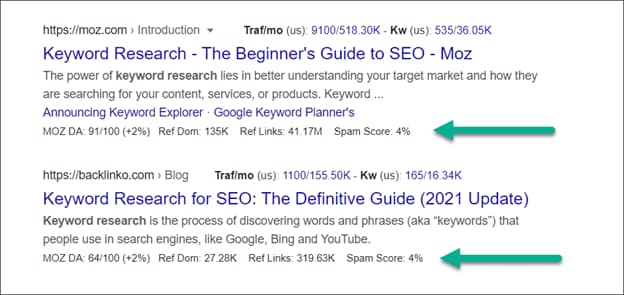While not a direct ranking factor, Domain Authority (DA) is a great indicator of a website’s strength and may dictate how well a site performs in the search results.
In this article, let’s explore Domain Authority in detail and cite the best domain rank checker tools you can use to monitor your website and your competitors.
What is a Domain Authority?
Domain Authority (DA) was developed by Moz in 2004. It scores domains, not pages, from 1 to 100– the higher the score, the more likely it is to do well in search engine results pages (SERPs).
In 2019, Moz upgraded their Domain Authority metric based on a ‘neural network model’, which is heavily focused on link analysis. Thus, it primarily gauges the link profile of a domain based on data from Moz’s link index, which contains over 4 trillion links.
How Does Moz Calculate Domain Authority?
Moz developed Domain Authority to help users predict how well their site can rank on search engines. It’s a fairly robust overview of how a domain is doing in terms of off-site SEO. The higher the DA, the higher the site’s backlink strength.
However, Moz used to only look at the number of links. With the 2019 upgrade, Moz DA now measures the quality of links, spam score, and number of linking root domains (referring domains).
A newly launched website starts at a Domain Authority of 1. Once the site earns more high-quality backlinks, the DA is bound to increase. Take note that Moz DA is measured on a relative scale, which means that your site’s DA depends on other website’s DA as well. If other relative sites improve their link profile, your DA can still go down.
It’s also measured on a logarithmic scale. This means that increasing your DA gets tougher the more you move to a higher score. For instance, improving your DA from 10 to 12 is way easier than increasing DA 80 to DA 82.
That’s why you’ll see hundreds of millions of sites stuck under a DA of 10—while only a tiny handful ever get near 100.
What is a Good Domain Authority?
Domain authority works on a relative scale, comparing your site to others in your niche. If your score is 40 and your competitor’s is 35, you’re in a good position to outrank them in search results.
If you’re new to the concept of Domain Authority, a good first move is to compare your DA to the DA of your direct competitors. If their DA scores are somewhere between 30 and 40, that is a good score to target.
If you look at Domain Authority as a standalone metric, it doesn’t say much. If anything, it’s often considered a vanity metric. It’s only mainly useful when you compare your score with other websites, especially the competing sites. In fact, there are now shady techniques some people implement that manipulate DA scores, allowing sites with little to no organic keyword rankings to artificially inflate their Domain Authority.
Instead of chasing a higher DA just for show, it’s better to invest in the long-term growth of your site through proven SEO practices.
How to Increase Domain Authority
Increasing your Domain Authority is closely tied to boosting your website’s trust and credibility. While Moz’s DA isn’t a direct Google ranking factor, the efforts you make to improve it would naturally lead to better visibility and performance in search engine results pages.
Here are some tips for increasing your site’s Domain Authority:
1. Build high-quality backlinks
When it comes to link building, quality matters more than quantity. There are several effective strategies to earn quality backlinks, including guest posting, claiming local listings, broken link building, and running active PR campaigns—among other off-page SEO tactics. The goal is to steadily grow the number of reputable referring domains over time. Just as important, avoid linking to or getting links from shady websites, as this can increase your spam score and harm your site’s credibility.
2. Improve on-page SEO
On-page SEO is foundational in any SEO-related campaign. Keyword research, content optimization, UX improvement, and technical optimization can all help both users and search engines understand and navigate your website.
3. Regularly produce high-quality content
Regularly publishing relevant and high-quality content signals search engines that your site is active and provides value. Make sure to do proper keyword research to make every informational article as targeted and optimized as possible.
4. Make your website mobile-friendly
Even if you have a robust backlink profile, if Google penalizes your site in search rankings due to mobile experience, your visibility and traffic can still drop significantly.
5. Improve website loading speed
Google has explicitly stated that site speed is a ranking factor. To make sure that your off-page SEO efforts don’t go to waste, monitor your website performance and optimize loading times across all devices.
6. Increase social media activity
Social media engagement can boost collective SEO success. The main goal of social media is increased brand awareness that can potentially drive more organic traffic. The more you expose your brand on social media, the more you can become top-of-mind, which can help attract branded searches and strengthen your overall digital presence.
7. Remove bad links
Remember that Moz DA and even Google itself has their own algorithms and systems for detecting spam and gauging website quality. You should monitor both inbound and outbound links and make sure that all links you’re associating your website to are high-quality.
Look out for low-quality links as well as broken links which can harm both your metric-based Domain Authority and real-world reputation. Do a quarterly audit of your backlink profile and use Google’s Disavow tool to remove any bad links. If you’re experiencing a manual penalty or being targeted by negative SEO, perform audits more frequently.
How Do You Check Domain Authority?
Now, is Moz DA your only choice for checking domain authority? Quick answer is no. Although it’s the pioneer in this metric, other popular SEO tools have created their own versions of Domain Authority.
Let’s Explore your options for checking your site’s DA:
1. Moz Link Explorer
You need to subscribe to Moz Pro in order to access the popular MozBar. Their plans start at $49 per month which already includes keyword research, competitive research, keyword tracking, and site tracking functionalities. Being the creator of DA, Moz provides one of the most trusted metrics for evaluating website authority and backlink strength.
2. Keywords Everywhere
If you want a more cost-effective way of accessing MozBar data, you can install Keywords Everywhere.
We use Moz’s Link Metrics API to display Domain Authority, referring domains, backlinks, spam score among other keyword data. There’s even a percentage number next to the DA to indicate if the DA has increased or decreased over the past year.

3. Ahrefs
Ahrefs’ version of the domain authority metric is called Domain Rating (DR). It still performs the same function of gauging the relative strength of a website’s backlink profile. It’s also measured on a logarithmic scale ranging from 0 to 100.
Ahrefs’ DR metric is entirely link-based– components like website traffic, historical domain age, spam level, or brand visibility aren’t factored into the score. Ahrefs’ Lite Plan is at $129 per month.
4. SEMrush
SEMrush’s DA metric is called Authority Score, measuring relative SEO strength and overall site quality on a scale of 0 to 100. and it’s calculated based on multiple components like backlink signals, organic traffic, and spam factors.
Just open SEMrush’s Backlink Analytics tool to view a site’s Authority Score along with detailed insights into its backlink profile and SEO health. You need to subscribe to one of their SEO plans to access this functionality. SEMrush pricing starts at $139.95/mo.
5. Majestic SEO
In link building, both quality and quantity are factors to consider. Majestic SEO made it even easier to measure both using their Citation Flow (CF) and Trust Flow (TF) metric, available under their Lite Plan at $49.99 per month.
The Citation Flow gauges the sheer number of links pointing to a website while Trust Flow focuses on the quality and trustworthiness of those backlinks. It’s not hard to increase your Citation Flow, especially since it leans heavily on link quantity. But if you overdo it without improving Trust Flow, you risk appearing like a site supported by weak or spammy links.
The thing is, both link quality and quantity play a role in SEO. High-quality links can significantly improve your rankings, but they can also be more difficult and time-consuming to build. If you’re just starting out, focusing on building a solid number of backlinks is a reasonable strategy—as long as you avoid spammy sources and keep your link profile natural. Pursuing a mix of medium-quality backlinks and consistently providing value online will help your domain’s authority grow steadily over time.
Conclusion
If your site is new, don’t worry if you don’t see immediate progress in terms of Domain Authority. Almost everything related to SEO takes time.
Think of Domain Authority as a progress indicator rather than a goal in itself. It reflects how your site is doing compared to others in your space and can help you track the impact of your link-building and content strategies over time.
While Domain Authority isn’t part of Google’s algorithm, it’s one of the tools in the digital tool box that can help you chart the success of your SEO campaign.


